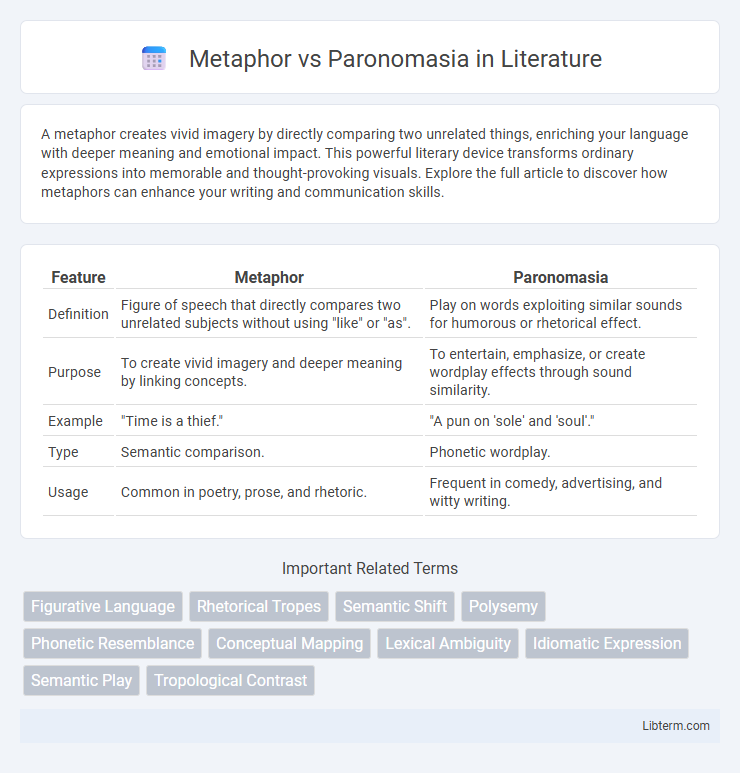A metaphor creates vivid imagery by directly comparing two unrelated things, enriching your language with deeper meaning and emotional impact. This powerful literary device transforms ordinary expressions into memorable and thought-provoking visuals. Explore the full article to discover how metaphors can enhance your writing and communication skills.
Table of Comparison
| Feature | Metaphor | Paronomasia |
|---|---|---|
| Definition | Figure of speech that directly compares two unrelated subjects without using "like" or "as". | Play on words exploiting similar sounds for humorous or rhetorical effect. |
| Purpose | To create vivid imagery and deeper meaning by linking concepts. | To entertain, emphasize, or create wordplay effects through sound similarity. |
| Example | "Time is a thief." | "A pun on 'sole' and 'soul'." |
| Type | Semantic comparison. | Phonetic wordplay. |
| Usage | Common in poetry, prose, and rhetoric. | Frequent in comedy, advertising, and witty writing. |
Introduction to Metaphor and Paronomasia
Metaphor is a figure of speech that involves describing one thing by directly comparing it to another, highlighting similarities to convey meaning or evoke imagery. Paronomasia, commonly known as punning, exploits the multiple meanings or similar sounds of words to create a play on words often used for humorous or rhetorical effect. Understanding the distinctions between metaphor and paronomasia enhances the ability to analyze literary devices and appreciate nuanced language use.
Defining Metaphor: Meaning and Function
Metaphor is a linguistic device that conveys meaning by directly comparing two unrelated concepts, enriching communication through symbolic representation. It functions to create vivid imagery and deepen understanding by linking abstract ideas to concrete experiences. Unlike paronomasia, which relies on wordplay and phonetic similarities, metaphor emphasizes semantic connections and conceptual transformation.
Understanding Paronomasia: A Play on Words
Paronomasia, a rhetorical device exploiting similar-sounding words or homophones, creates humor or emphasis through wordplay, distinct from metaphor's figurative associations. This linguistic technique relies on phonetic similarities, often generating puns that enhance memorability and engagement in communication. Understanding paronomasia involves recognizing its function to entertain, persuade, or highlight nuances by twisting meanings within context.
Historical Origins of Metaphor and Paronomasia
Metaphor traces its historical origins to ancient Greek philosophy, with Aristotle's "Poetics" providing one of the earliest systematic analyses of metaphor as a cognitive and linguistic tool for understanding and expression. Paronomasia, or punning, has roots in classical rhetoric and literature, notably present in Latin and Greek texts where wordplay served both comedic and persuasive functions. Both devices have evolved through centuries of literary tradition, reflecting cultural shifts in language use and creative expression.
Key Differences Between Metaphor and Paronomasia
Metaphor is a figure of speech that directly compares two unrelated concepts by stating one is the other to imply a shared quality, while paronomasia involves wordplay exploiting similar sounds or multiple meanings of words for humor or rhetorical effect. The key difference lies in their linguistic function: metaphors create vivid imagery through symbolic association, whereas paronomasia relies on phonetic similarity and punning for playful or persuasive impact. Understanding these distinctions helps in analyzing literary devices and enhancing communicative precision.
Functions of Metaphor in Communication
Metaphors function as powerful cognitive tools that enhance communication by enabling abstract or complex concepts to be understood through familiar terms, promoting clarity and emotional resonance. They facilitate intuitive insight and creative engagement by linking disparate ideas, thereby enriching the interpretative depth of messages. Unlike paronomasia, which relies on wordplay and phonetic similarity for humor or emphasis, metaphors shape thinking patterns and influence perception in discourse.
Paronomasia in Literature and Everyday Language
Paronomasia, or wordplay based on similar sounds, enriches both literature and everyday language by creating layered meanings and humor. In literary works, authors use paronomasia to enhance thematic depth and engage readers through clever linguistic twists. Everyday conversations employ paronomasia to add wit, facilitate memorability, and foster social connection through playful language.
Cognitive Impact: How Metaphor and Paronomasia Shape Thought
Metaphors enhance cognitive processing by mapping familiar concepts onto unfamiliar ideas, facilitating deeper understanding and abstract thinking. Paronomasia, or wordplay, stimulates cognitive flexibility by engaging phonological and semantic ambiguities, which fosters creative problem-solving and humor-driven learning. Both rhetorical devices uniquely influence mental representation and linguistic creativity, optimizing memory retention and conceptual connections.
Common Examples of Metaphor vs Paronomasia
Metaphor commonly appears in expressions like "time is a thief," illustrating one thing by directly linking it to another with shared qualities. Paronomasia, or punning, often involves wordplay based on similar sounds, as seen in phrases like "I used to be a banker but I lost interest," highlighting humor through lexical ambiguity. Understanding these distinct rhetorical devices enhances both literary appreciation and effective communication.
Conclusion: Choosing Between Metaphor and Paronomasia
Selecting between metaphor and paronomasia depends on the desired impact and clarity in communication; metaphor offers vivid imagery that enhances conceptual understanding, while paronomasia relies on wordplay to engage and entertain with clever linguistic twists. Effective use of metaphor enriches narrative depth by connecting abstract ideas to tangible experiences, whereas paronomasia adds humor and wit, making text memorable through phonetic resemblance. Writers should weigh audience expectations and purpose, opting for metaphor when seeking profound resonance and for paronomasia when aiming for playful or persuasive effects.
Metaphor Infographic

 libterm.com
libterm.com